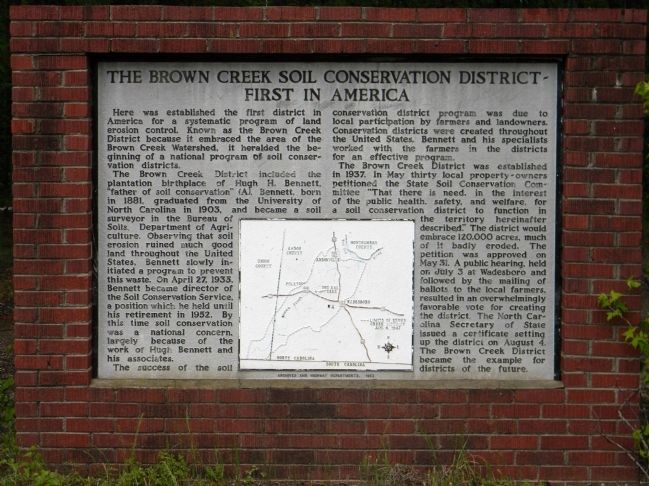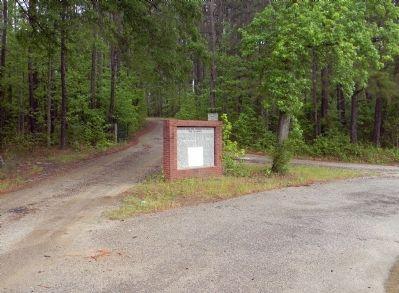Near Polkton in Anson County, North Carolina — The American South (South Atlantic)
Brown Creek Soil Conservation District
First in America
The Brown Creek District included the plantation birthplace of Hugh H. Bennett, “father of soil conservation.” Bennett, born in 1881, graduated from the University of North Carolina in 1903, and became a soil surveyor in the Bureau of Soils, Department of Agriculture. Observing that soil erosion ruined much good land throughout the United States, Bennett slowly initiated a program to prevent this waste. On April 27, 1935, Bennett became director of the Soil Conservation Service, a position he held until his retirement in 1952. By this time soil conservation was a national concern, largely because of the work of Hugh Bennett and his associates.
The success of the soil conservation district program was due to local participation by farmers and landowners. Conservation districts were created throughout the United States. Bennett and his specialists worked with the farmers in the districts for an effective program.
The Brown Creek District was established in 1937. In May thirty local property-owners petitioned the State Soil Conservation Committee “that there is need, in the interest of the public health, safety, and welfare, for a soil conservation district to function in the territory hereinafter described.” The district would embrace 120,000 acres, much of it badly eroded. The petition was approved on May 31. A public hearing, held on July 3 at Wadesboro and followed by the mailing of ballots to the local farmers, resulted in an overwhelmingly favorable vote for creating the district. The North Carolina Secretary of State issued a certificate setting up the district on August 4. The Brown Creek District became the example for districts of the future.
Erected 1962 by North Carolina Archives and Highway Departments. (Marker Number KK-1.)
Topics and series. This historical marker is listed in this topic list: Agriculture. In addition, it is included in the North Carolina Division of Archives and History series list. A significant historical month for this entry is April 1823.
Location. 34° 59.607′ N, 80° 10.006′ W. Marker is near Polkton, North Carolina, in Anson County. Marker is on Andrew Jackson Highway (U.S. 74) 0.4 miles west of Boylin Road (North Carolina Highway 1420), on the right when traveling west. The Brown Creek Soil Conservation District marker is located at a road side pull off only accessible from the
westbound lanes of US-74 (Andrew Jackson Highway). Touch for map. Marker is in this post office area: Polkton NC 28135, United States of America. Touch for directions.
Other nearby markers. At least 8 other markers are within 8 miles of this marker, measured as the crow flies. Leonidas L. Polk (approx. 2.7 miles away); Hugh Hammond Bennett (approx. 3.8 miles away); Anson County Training School (approx. 4.7 miles away); Blind Boy Fuller (approx. 5.4 miles away); 1900 Total Solar Eclipse (approx. 5.4 miles away); Boggan-Hammond House (approx. 5˝ miles away); Thomas Samuel Ashe (approx. 6.1 miles away); Sherman's March (approx. 7.8 miles away).
Related marker. Click here for another marker that is related to this marker. To better understand the relationship, study the marker shown.
Also see . . . USDA Natural Resources Conservation Service. North Carolina has played an important role in the historical development of soil conservation and the Natural Resources Conservation Serivce. Hugh Hammond Bennett, the Father of Soil Conservation, was a native of North Carolina and the first Soil and Water Conservation District was founded in this state. (Submitted on May 13, 2011, by PaulwC3 of Northern, Virginia.)
Credits. This page was last revised on February 22, 2021. It was originally submitted on May 12, 2011, by PaulwC3 of Northern, Virginia. This page has been viewed 1,001 times since then and 43 times this year. Photos: 1, 2. submitted on May 12, 2011, by PaulwC3 of Northern, Virginia.

